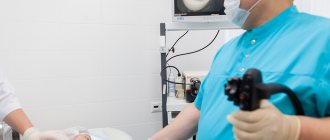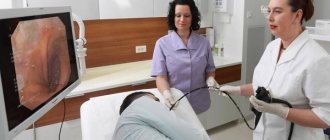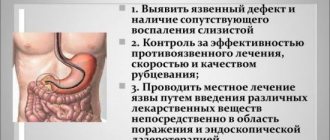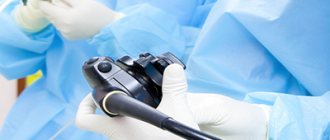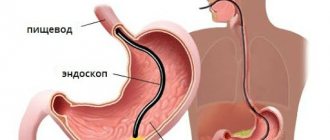Diagnosis of diseases of the digestive tract often requires the use of instrumental methods. Carrying out some research methods can be accompanied by significant discomfort and even pain.
Gastroscopy under anesthesia is an excellent way to make an informative examination of the gastrointestinal tract painless for the patient. This procedure has contraindications that should be discussed with your doctor.
What is gastroscopy of the stomach
This is an endoscopic method of examining the gastric mucosa using a special device - a gastroscope. The device is a long, hollow tube of small diameter, one end of which is equipped with a video camera and a light bulb (this part of the tube is inserted through the mouth into the esophagus and lowered into the patient’s stomach), and the other end of the tube is connected to a computer, the monitor of which displays an image of what the device “sees” from inside the gastrointestinal tract. The gastroscope also has special holes through which the doctor can insert instruments for biopsy or other surgical procedures. Thanks to this, the procedure allows you to combine not only diagnostics, but also therapeutic functions.
After the prescribed examination, consult with your therapist.
If gastritis was detected during the research, it is necessary to additionally diagnose helicobacter pylori. This can be done using several tests: determination of antibodies in the blood (if the patient has not previously been treated for this infection); examination of biopsy samples of the gastric mucosa.
Some stomach diseases require adherence to a certain diet; your doctor will tell you about the required diet. The patient must strictly follow all prescriptions throughout the entire treatment period. The duration of treatment is also determined by the doctor, who also sets a date for re-examination. After completion of treatment, it is necessary to evaluate its effectiveness; this can be done only a month after stopping the medication.
Why do gastroscopy
- nonspecific complaints from the gastrointestinal tract (pain, nausea, vomiting, discomfort in the epigastric region, metallic taste in the mouth, heartburn, belching);
- suspicions of gastrointestinal cancer;
- stomach polyps;
- exacerbation of chronic gastrointestinal problems;
- unmotivated weight loss;
- a decrease in hemoglobin and red blood cells in a general blood test, which is difficult to correct with iron-containing drugs.
These indications are scheduled: the procedure is scheduled for a certain day, the patient prepares for manipulation. There are also emergency indications, they characterize dangerous, sometimes life-threatening conditions in which the patient urgently needs to examine the gastric mucosa or undergo therapeutic manipulation. Emergency gastroscopy is performed when:
- perforated ulcer;
- bleeding from the gastrointestinal tract;
- entry of foreign objects into the gastrointestinal tract.
When should you do research?
Endoscopy is prescribed in many cases; it is an informative method that makes it possible to timely diagnose diseases that are dangerous to life and health. Indications have a wide range - these are:
- nausea, frequent vomiting;
- difficulty eating;
- pain of various types in the stomach area;
- presence of symptoms of gastric bleeding;
- check to evaluate the ongoing treatment of the gastrointestinal tract;
- suspicion of the presence of cancer of the esophagus, stomach or duodenum.
A child may be prescribed this procedure for pain or if foreign bodies enter the stomach.
What does gastroscopy of the stomach show and how is it performed?
The camera at the end of the endoscopic device, entering through the esophagus into the stomach, allows you to visualize its inner wall, the mucous membrane, defects and growths on it, the contents of the organ: mucus, bile, blood. The procedure can be carried out plannedly, with the preparation of the patient, as well as estrantly - with serious life-threatening conditions. The patient is placed on his left side, placing a cushion under his head. The oropharynx is treated with lidocaine spray to reduce the gag reflex. Wait a few minutes until the “freezing” effect occurs. A mouthpiece is inserted into the patient’s mouth to prevent the jaws from closing during the procedure. The end of the device with a video camera at the end is placed on the root of the tongue and the patient is asked to make swallowing movements. Gently, with minimal pressure, the doctor moves the device along the esophagus, reaching the gastric cavity. Rotating the endoscope, the doctor examines the mucous membrane, cardiac, pyloric region, and fundus of the stomach. If there are indications, a biopsy can be taken through a probe - a piece of mucous membrane that has aroused the doctor’s suspicions. The image that the endoscope “sees” is displayed on the monitor screen, allowing the doctor and assistants to examine the gastric walls in detail.
How long does the procedure take?
If the picture that the doctor sees does not arouse his suspicions and does not force him to study the inner lining in more detail, the procedure will go faster. If no stomach problems are detected, inserting and removing the tube may take 5-7 minutes. If there are areas inside the gastrointestinal tract that require deeper visual examination, or a biopsy or surgical manipulation is required, then gastroscopy may take 15-30 minutes.
If the patient is calm and balanced, listens to the commands of the medical staff and follows instructions, breathes correctly during the procedure, and does not interfere with the doctor’s actions, the speed of the examination increases significantly. “Swallowing a tube” is not a pleasant procedure, but it would not be fair to call it painful. It hurts - no. Unpleasant - yes. Typically, patients are frightened by the very fact that a foreign body - an endoscope - will be inserted into the esophagus. To reduce the degree of discomfort during manipulation, a positive attitude, calmness and trust in the doctor are important.
Who is contraindicated for
Gastroscopy under anesthesia is not performed in a number of cases:
- stenosis, which prevents normal insertion of the device tip;
- chemical burns of mucous membranes;
- tract injuries resulting from foreign bodies;
- mediastinitis – inflammation of the tissue;
- dissecting aortic aneurysm;
- thinning of the walls of blood vessels and high risks of bleeding;
- heart attack, stroke.
Restrictions apply to patients with severe curvature of the spine, large goiter, severe forms of cardiopulmonary failure, neurological and mental disorders, and hemophilia.
How to undergo a gastroscopy painlessly
You need to be aware of the progress of the procedure, not be embarrassed when, as the tube is advanced, belching and salivation reflexively occur (these are physiological reactions of the body that should not be embarrassed), try to relax. If you follow all the above recommendations, it is more likely to pass with less discomfort If your knees are shaking from fear and you can’t get yourself ready for the examination, you can do the procedure under anesthesia. An anesthetic is injected into a vein, which puts the patient to sleep. After gastroscopy is performed and the probe is removed, the patient is woken up. There are no memories of the manipulation left in his memory.
How to breathe correctly during gastroscopy
Before inserting the probe into the esophagus, the doctor will ask you to take several deep breaths and exhales; after the next inhalation, the device is installed at the root of the tongue, and as you exhale, you should make a swallowing movement. After which the device slides inside. The patient’s task is to then breathe calmly through the mouth, take a leisurely breath, and then exhale. If the patient has problems breathing due to anxiety or discomfort, then the nurse nearby will certainly calm him down and tell him how to breathe correctly. We must not panic. It is impossible to suffocate during this study, because the airways, nasopharynx and trachea, are absolutely free.
How often can and should you do a gastroscopy?
For patients with chronic gastric diseases without exacerbations, doctors recommend endoscopic examination at least once a year. This is necessary to monitor the dynamics of the disease; observation allows you to monitor whether there are any deteriorations in your health, and if they are detected in a timely manner, eliminate them with therapy. With the progression of the disease, exacerbation of chronic processes, gastroscopy is prescribed more often, on the recommendation of the attending physician. Often the procedure is prescribed to monitor the effectiveness of treatment. There are no restrictions on the manipulation, provided that it is performed without complications.
How to prepare
Gastroscopy is performed on an empty stomach, so you must give up water and food 8-12 hours before. The only exceptions are emergency cases, in which urgent gastric emptying is performed using a tube.
It is important to remember that at least 3 days must pass after an X-ray of the gastrointestinal tract using contrast. Only after this can EGDS be performed.
Before gastroscopy under anesthesia, the doctor explains to the patient the purpose of the examination and the features of all manipulations. The procedure is carried out in a state of medicated sleep. If there is reason to suspect possible contraindications to anesthesia, additional preparation will be required. It consists of conducting a preliminary examination: ECG, laboratory tests, consultation with a therapist, etc.
Preparation also includes the processing of instruments: the endoscope and the instruments used are disinfected, which eliminates the risk of infection.
Contraindications
This diagnostic method has its contraindications. It is not indicated if the patient has:
- recent heart attack or stroke;
- severe renal or liver failure;
- acute infectious diseases;
- acute psychotic disorder;
- disruption of rhythm;
- cachexia;
- extreme obesity (in some cases);
- hemophilia.
For emergency manipulation, gastroscopy can also be done if you have a cold. If suddenly the illness occurs at the time of the scheduled appointment, it is better to postpone the endoscopy until recovery. The fact is that most often with colds, the infection is localized in the area of the nasopharynx and larynx. There is a high probability that, together with the endoscopic tube, which will move through the infected oral cavity, pharynx, it will “introduce” an infection into the stomach. Swelling nasal mucosa, congestion or nasal discharge will make breathing difficult, coughing will also interfere with the procedure, cause discomfort to the patient and complicate the work to the doctor.
Pregnancy
During pregnancy, gastroscopy can be done. An endoscopic examination of a pregnant woman is indicated for suspected intragastric bleeding, developing oncological processes in the gastrointestinal tract, or exacerbation of existing chronic diseases.
It is safest to carry out the study in the first and early second trimesters.
Critical days
Menstruation is not a contraindication for this study. It is possible to do gastroscopy during menstruation. In some women, in the first days of menstruation, their general health sharply worsens: pain in the lower abdomen, severe weakness and irritability are bothersome. If the patient has these symptoms in the first days of the cycle, and it is during this period that a planned endoscopy falls, then it is better to reschedule the study. But if menstruation does not affect the physical condition of the woman in any way, then the diagnosis of the stomach should not be canceled.
Teeth cleaning
It is not advisable to brush your teeth on the day of the examination. When toothpaste enters the stomach, the production of hydrochloric acid and gastric juice begins. Accumulated secretions in the organ cavity can cause visualization of the internal walls with the device.
Dos and don'ts before and after gastroscopy
If the procedure was carried out without the use of intravenous anesthesia using only lidocaine treatment of the pharynx, then it is allowed to eat and drink immediately after the “freeze” has gone away - the sensitivity of the mucous membrane is restored - 10-15 minutes after the examination. If intravenous anesthesia was used, 1- The patient must be under the supervision of medical personnel for 2 hours after the examination. You must not drive for 12 hours. It is not advisable to drink alcoholic beverages during the 24 hours after the examination.
Features of endoscopy under anesthesia
When performing endoscopy of the stomach under general anesthesia, intubation of the respiratory tract is performed - a special tube is installed that ensures normal air passage.
Medication-induced sleep during the procedure lasts no more than 30-40 minutes. During this time, it is possible not only to conduct a complete diagnosis of the organs, but also to perform additional medical procedures - take a biopsy, remove tumors, stop bleeding, treat ulcers, cauterize erosion, etc.
If desired, the entire examination can be recorded on DVD or other digital media. The recording will allow you to obtain another opinion from an independent expert, as well as track the dynamics of the development of the disease and the effectiveness of treatment therapy.
At a medical clinic in St. Petersburg, you can undergo endoscopy of the stomach, duodenum and colon under general anesthesia. Experienced anesthesiologists and modern anesthetics will help you avoid pain, discomfort and fear before the examination. Pre-registration by phone: 8 (812) 322-93-90, or using the online registration form on the website.
Preparing the patient for the gastroscopy procedure
In order for the study to be informative, to be successful, and for no complications to arise during its implementation, the patient is required to strictly follow the simple rules of preparation for it.
- 2-3 days before the planned procedure you should not eat chocolate or nuts;
- The last meal should be no later than 12 hours before the study. If gastroscopy is scheduled the next morning, then a light dinner is allowed at 18.00 - boiled meat, oatmeal;
- After dinner at 18.00 you cannot eat. In the evening you can drink water. It should be remembered that milk is not a liquid, but a food, so a glass of milk the night before the procedure is not allowed;
- on the morning of the endoscopy, it is strictly forbidden to eat, drink, brush your teeth, or use chewing gum;
- It is not recommended to smoke on the eve of the study.
Even a small amount of water, toothpaste, entered into the stomach on the eve of the study, components of tobacco smoke can provoke excessive secretion of mucus, hydrochloric acid, thereby distorting the data obtained. Eating before the procedure is fraught with vomiting right during gastroscopy. This is very dangerous due to vomit entering the respiratory tract and aspiration.
How to prepare for gastroscopy of the stomach with biopsy
Whether a biopsy is performed during an endoscopic examination or not has absolutely no effect on the patient’s preparation for examination. A biopsy means taking a piece of the gastric mucosa from an area that raises the doctor’s suspicion: an inflamed lesion, the edge of an ulcer or erosion, for microscopic, bacteriological, cytological examination .
Preparation for gastroscopy in the morning and afternoon
The main rule of preparation for the procedure: do not eat 12 hours and do not drink 4 hours before the examination. This must be followed regardless of what time the examination is scheduled for. You can wait longer periods without food and drink, but shorter periods are not allowed. If the examination is scheduled in the morning at 9.00, then it is advisable to take the last meal no later than 18.00, if the patient can easily tolerate the state of hunger, or no later than 20.00, if he is used to having dinner late. The food should be light. If the examination is scheduled in the afternoon, then the last meal (light dinner) can be taken at 22.00, but not eaten in the morning. In the morning you can drink water, but no later than 4 hours before the start of the procedure.
In what cases is the procedure prohibited?
But not all patients can undergo this examination. There are quite a few absolute contraindications that prohibit internal examination of the digestive system. This includes:
- hypertension;
- various heart diseases;
- obesity 2–3 degrees;
- pyloric stenosis (narrowing of the passage);
- high degree curvature of the spine (scoliosis, kyphosis);
- history of heart attack or stroke;
- blood pathologies.
Contraindications are considered relative, in which the doctor makes a decision based on the need for this diagnosis, taking into account the patient’s condition. These include children under 6 years of age, exacerbation with an ulcer or chronic gastritis, severe mental illness, and inflammatory processes in the respiratory tract. Even a child needs to have a gastroscopy if there is heavy bleeding or a foreign body gets inside.
What you can’t and can’t eat before gastroscopy of the stomach
For a few days, it is advisable to eliminate nuts, smoked meats, chocolate, fried and fatty foods, legumes, cabbage, fresh vegetables and fruits and other foods that cause increased gas formation. You cannot drink carbonated drinks. It is recommended to consume boiled meat, oatmeal, buckwheat porridge, and fermented milk products the day before. It is not advisable to consume alcoholic beverages 2-3 days before the test and are strictly contraindicated to take the day before. It should be remembered that milkshakes and milk in their pure form - This is not a drink, but a complete meal. And a glass of milk drunk 4-8 hours before the test is equivalent to a meal, which means it is also contraindicated.
How long after gastroscopy can you eat?
If local anesthesia of the pharynx with lidocaine was used during gastroscopy, then you can eat as soon as the sensitive receptors of the tongue and pharynx are restored, and the medicine stops working - 10-15 minutes after the end of the manipulation. If intravenous anesthesia was performed, after 1.5-2 hours after regaining consciousness, provided that no complications arose during the study. You should not eat hot, spicy food that can irritate the mucous membrane, especially if it was mechanically irritated - a biopsy. Food should be easily digestible, preferably warm. Slimy porridge, cottage cheese, fermented milk products, boiled chicken, mashed potatoes are quite acceptable as a meal.
Diagnosis and examination of the stomach without gastroscopy
This method of diagnosing the gastric mucosa is the most informative today; it allows you to macroscopically visualize the inner wall of the organ, as well as take material for a more detailed study and accurate diagnosis. There are other examination methods that complement or partially replace the endoscopic one: These methods can only partially replace endoscopic examination, because neither ultrasound, nor X-ray, nor MRI allows taking a biopsy and confirming the diagnosis at the cellular level.
How to determine stomach acidity during gastroscopy
The endoscopic method can reliably determine the level of acidity of the gastric contents. If gastroscopy is not possible, we can assume increased acidity in the clinic: the patient will complain of heartburn, sour belching, a metallic taste in the mouth. Another way to determine pH is the acid test: the patient drinks a special preparation from which, when interacting with gastric juice, a dye is released, after which it is excreted in the urine. Gastric pH is determined by the color of urine.
What is the difference between gastroscopy and endoscopy?
This is a special case of endoscopic examination. It is not correct to assume that these are different concepts. The initial sections of the gastrointestinal tract include the pharynx, esophagus, stomach, and duodenum. If only the stomach is examined endoscopically, the manipulation is called gastroscopy; if the duodenum is examined, duodenoscopy; if all initial sections, including the esophagus, are examined, esophagogastroduodenoscopy is used. All manipulations are carried out using a flexible probe and are types of endoscopy.
Which is better - MRI or gastroscopy?
MRI is a painless procedure that perfectly visualizes tumor processes in the abdominal cavity, metastases, and the condition of the organ and tissues. However, during the procedure, it is impossible to take a biopsy of the mucosa for a more detailed cellular study.
Fibrogastroscopy and gastroscopy - what is the difference
The prefix fibro- indicates that the study is carried out with a flexible probe. Previously, the manipulation could be carried out with simpler equipment, but today all clinics and hospitals are equipped with modern devices for carrying out this procedure.
Ultrasound of the stomach or gastroscopy
A more informative method from a diagnostic point of view for gastric pathology is gastroscopy. If it is contraindicated or impossible, complementary methods are used, one of which is ultrasound. Ultrasound for gastric diseases is rarely prescribed today. Not all diseases can be visualized echographically, and it is also impossible to assess the condition of the mucous membrane using a biopsy - these nuances limit the doctor’s prescription for this procedure.
Survey results
The endoscopist receives the first results immediately during the examination. Visual examination of the internal surface of organs allows you to get a general picture of the condition and make a diagnosis: gastritis, colitis, peptic ulcer, etc. Tumors and formations are also immediately visible. If a biopsy is performed simultaneously with endoscopy, the material is sent to the laboratory for study. The results of histological or cytological examination will be ready within 5-7 days.
The conclusion of the endoscopist includes not only a description of the structural features of the organs and diagnosis, but also photos of the localization of defects when they are detected.
